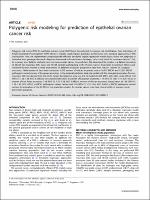| dc.contributor | Vall d'Hebron Barcelona Hospital Campus |
| dc.contributor.author | Dareng, Eileen O. |
| dc.contributor.author | Tyrer, Jonathan |
| dc.contributor.author | Jones, Michelle R. |
| dc.contributor.author | Yang, Xin |
| dc.contributor.author | Aben, Katja |
| dc.contributor.author | Balmaña Gelpí, Judith |
| dc.contributor.author | Diez Gibert, Orland |
| dc.contributor.author | Barnes, Daniel |
| dc.date.accessioned | 2022-09-06T09:08:53Z |
| dc.date.available | 2022-09-06T09:08:53Z |
| dc.date.copyright | 2021 |
| dc.date.issued | 2022-03 |
| dc.identifier.citation | Dareng EO, Tyrer JP, Barnes DR, Jones MR, Yang X, Aben KKH, et al. Polygenic risk modeling for prediction of epithelial ovarian cancer risk. Eur J Hum Genet. 2022 Mar;30:349–362. |
| dc.identifier.issn | 1476-5438 |
| dc.identifier.uri | https://hdl.handle.net/11351/8031 |
| dc.description | Clinical genetics; Genetic markers; Risk factors |
| dc.description.abstract | Polygenic risk scores (PRS) for epithelial ovarian cancer (EOC) have the potential to improve risk stratification. Joint estimation of Single Nucleotide Polymorphism (SNP) effects in models could improve predictive performance over standard approaches of PRS construction. Here, we implemented computationally efficient, penalized, logistic regression models (lasso, elastic net, stepwise) to individual level genotype data and a Bayesian framework with continuous shrinkage, “select and shrink for summary statistics” (S4), to summary level data for epithelial non-mucinous ovarian cancer risk prediction. We developed the models in a dataset consisting of 23,564 non-mucinous EOC cases and 40,138 controls participating in the Ovarian Cancer Association Consortium (OCAC) and validated the best models in three populations of different ancestries: prospective data from 198,101 women of European ancestries; 7,669 women of East Asian ancestries; 1,072 women of African ancestries, and in 18,915 BRCA1 and 12,337 BRCA2 pathogenic variant carriers of European ancestries. In the external validation data, the model with the strongest association for non-mucinous EOC risk derived from the OCAC model development data was the S4 model (27,240 SNPs) with odds ratios (OR) of 1.38 (95% CI: 1.28–1.48, AUC: 0.588) per unit standard deviation, in women of European ancestries; 1.14 (95% CI: 1.08–1.19, AUC: 0.538) in women of East Asian ancestries; 1.38 (95% CI: 1.21–1.58, AUC: 0.593) in women of African ancestries; hazard ratios of 1.36 (95% CI: 1.29–1.43, AUC: 0.592) in BRCA1 pathogenic variant carriers and 1.49 (95% CI: 1.35–1.64, AUC: 0.624) in BRCA2 pathogenic variant carriers. Incorporation of the S4 PRS in risk prediction models for ovarian cancer may have clinical utility in ovarian cancer prevention programs. |
| dc.language.iso | eng |
| dc.publisher | Springer Nature |
| dc.relation.ispartofseries | European Journal of Human Genetics;30 |
| dc.rights | Attribution 4.0 International |
| dc.rights.uri | http://creativecommons.org/licenses/by/4.0/ |
| dc.source | Scientia |
| dc.subject | Ovaris - Càncer - Aspectes genètics |
| dc.subject | Ovaris - Càncer - Propensió |
| dc.subject.mesh | Carcinoma, Ovarian Epithelial |
| dc.subject.mesh | /genetics |
| dc.subject.mesh | Genetic Predisposition to Disease |
| dc.title | Polygenic risk modeling for prediction of epithelial ovarian cancer risk |
| dc.type | info:eu-repo/semantics/article |
| dc.identifier.doi | 10.1038/s41431-021-00987-7 |
| dc.subject.decs | carcinoma epitelial de ovario |
| dc.subject.decs | /genética |
| dc.subject.decs | predisposición genética a la enfermedad |
| dc.relation.publishversion | https://doi.org/10.1038/s41431-021-00987-7 |
| dc.type.version | info:eu-repo/semantics/publishedVersion |
| dc.audience | Professionals |
| dc.contributor.organismes | Institut Català de la Salut |
| dc.contributor.authoraffiliation | [Dareng EO, Barnes DR, Yang X] University of Cambridge, Centre for Cancer Genetic Epidemiology, Department of Public Health and Primary Care, Cambridge, UK. [Tyrer JP] University of Cambridge, Centre for Cancer Genetic Epidemiology, Department of Oncology, Cambridge, UK. [Jones MR] Center for Bioinformatics and Functional Genomics, Cedars-Sinai Medical Center, Los Angeles, CA, USA. [Aben KKH] Radboud University Medical Center, Radboud Institute for Health Sciences, Nijmegen, The Netherlands. Netherlands Comprehensive Cancer Organisation, Utrecht, The Netherlands. [Balmaña J] Hereditary cancer Genetics Group, Vall d’Hebron Institute of Oncology (VHIO), Barcelona, Spain. Servei d’Oncologia Mèdica, Vall d’Hebron Hospital Universitari, Barcelona, Spain. [Diez O] Oncogenetics Group, Vall d’Hebron Institute of Oncology (VHIO), Barcelona, Spain. Àrea de Genètica Clínica i Molecular, Vall d’Hebron Hospital Universitari, Barcelona, Spain |
| dc.identifier.pmid | 35027648 |
| dc.identifier.wos | 000742272300002 |
| dc.rights.accessrights | info:eu-repo/semantics/openAccess |

